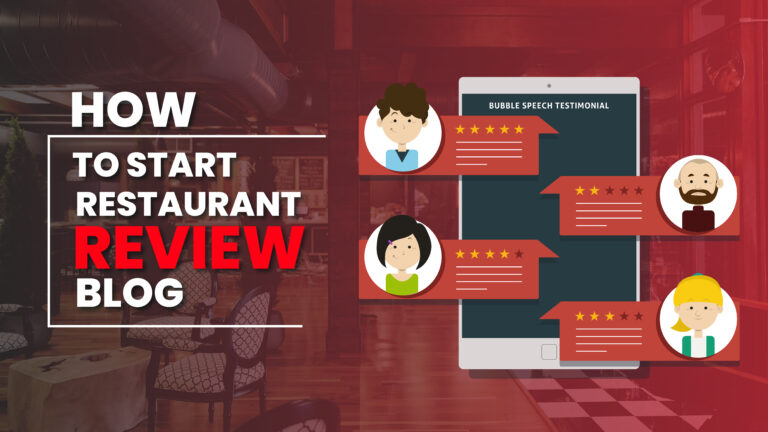Starting a restaurant review blog in 2026 requires a strategic and creative approach to stand out in the ever-growing world of food blogging. With new restaurants opening every day and dining trends constantly evolving, readers crave authentic, detailed, and visually engaging reviews. From choosing your niche, such as fine dining, street food, or local eateries, to crafting honest and well-written reviews, each step plays a vital role in building trust and authority.
A successful restaurant review blog not only shares opinions but also tells a story that connects food, ambiance, and culture. This comprehensive guide will walk you through how to launch, grow, and promote a restaurant review blog that keeps your audience hungry for more.
What is Restaurant Review Blog
A restaurant review blog is a type of food blog where writers share detailed insights, opinions, and experiences about dining at different restaurants, cafés, or eateries. The goal of a restaurant review blog is to help readers discover great places to eat by offering honest reviews on food quality, service, ambiance, pricing, and overall dining experience. These blogs often include high-quality photos, ratings, and recommendations to make the content more engaging and trustworthy.
In 2026, with people increasingly relying on online reviews before dining out, a well-crafted restaurant review blog can build strong credibility, attract a loyal audience, and even collaborate with food brands and restaurants for promotions. Many restaurant review bloggers also explore local food trends, interview chefs, or highlight hidden gems in their city.
How to Start a Restaurant Review Blog
Choose Your Niche
To start a restaurant review blog, select a specific niche. A niche helps differentiate your blog and targets a defined audience. Examples include reviewing fine dining establishments, budget-friendly eateries, street food, or specific cuisines like Italian or Japanese. According to Forbes, niche blogs perform better in search rankings and attract loyal readers. Identify a niche that matches your passion and market demand. Use keyword research tools like SEMrush or Ahrefs to determine what food-related content audiences are searching for.
Pick a Blogging Platform
To launch your restaurant review blog, choose a blogging platform. Popular platforms include WordPress, Wix, and Squarespace. WordPress is favored for its vast customization options and plugin support. It powers over 40% of websites, according to W3Techs. Wix provides drag-and-drop functionality, making it easy for beginners to design. Squarespace offers sleek templates that are visually appealing, which is critical for food blogs. Select a platform that meets your technical skills and design preferences.
Secure a Domain Name
To brand your blog effectively, select a memorable domain name. The domain name should reflect your niche and be easy to spell and remember. Short domain names are more effective for building a brand identity. Use domain registration services like GoDaddy or Namecheap to purchase and register your domain. Verify the availability of the name across social media platforms to ensure cohesive branding.
Set Up Hosting
To make your blog live, set up hosting. Reliable hosting ensures your blog performs smoothly and remains accessible. Hosting services like Bluehost and SiteGround are known for their reliability, speed, and customer support. PCMag rates SiteGround highly for its excellent uptime and customer service. Choose a plan that accommodates your expected traffic. Scalability is important as your blog grows, so opt for a host that allows for easy upgrades.
Design Your Blog
To make a lasting impression, design your blog with a user-friendly and attractive interface. A well-designed blog enhances user experience, and design plays a crucial role in engaging readers. Choose a theme or template that complements the food industry. Use high-quality images to make your reviews visually engaging. Incorporate essential features such as search functionality, navigation menus, social media buttons, and an “About” section that introduces you to readers. According to Smashing Magazine, a clean, intuitive design improves visitor retention.
Create High-Quality Content
To capture and retain readers, create high-quality, valuable content. A successful restaurant review blog offers honest, detailed reviews of restaurants, dishes, ambiance, and service. According to the Content Marketing Institute, valuable content builds trust and authority. Write in a factual, concise manner, and avoid overly opinionated statements. Incorporate descriptive language to provide readers with a clear picture of the dining experience. Use visuals like images and videos of the restaurant, dishes, and ambiance to enhance your content.
How to Write a Restaurant Review
To write an effective restaurant review, focus on several key elements:
Restaurant Atmosphere:
Describe the ambiance, decor, lighting, and seating arrangements. For example, is it cozy, modern, or upscale? Does it have unique artwork or lighting fixtures? Eater emphasizes that atmosphere is a key factor in a dining experience.
Service Quality:
Assess the friendliness and professionalism of the staff. Were they prompt and attentive? Did they offer recommendations? According to Zagat, service is one of the top factors in diners’ overall experience.
Menu Selection:
Analyze the variety and uniqueness of the menu. Does the restaurant offer a wide range of options? Are there any signature dishes? Look for creativity in presentation and ingredients.
Food Quality:
Focus on the taste, texture, presentation, and portion size. Describe how well the dishes are cooked and whether they meet expectations. Use specific adjectives to paint a clear picture for your readers. According to Food & Wine, great food descriptions elevate the review.
Pricing:
Mention the cost of the meal. Is the pricing reasonable for the quality? Do the portions justify the cost? Price is a key factor for many readers, as noted by The Guardian.
Overall Experience:
Conclude the review with an overall impression of the restaurant. Would you recommend it to others? Highlight key points like exceptional service or standout dishes that make the restaurant worth visiting.
Develop a Content Strategy
To keep your blog consistent, develop a content strategy. A solid content strategy ensures regular posting and engaging topics. Create a content calendar to schedule posts in advance. Write about trending restaurants, seasonal specials, or food festivals. Stay updated with local dining events to capture timely content. According to HubSpot, blogs with consistent posting schedules perform better in terms of engagement and traffic.
Optimize for SEO
To increase visibility, optimize your restaurant review blog for search engines. Search Engine Optimization (SEO) improves your blog’s ranking on Google and other search engines. Use relevant keywords, such as “best restaurants in [city]” or “top dishes in [restaurant name],” to target your audience. Tools like Yoast SEO can help optimize your blog posts for better visibility. Optimize images with alt text and compress them for faster loading times. According to Moz, SEO is essential for driving organic traffic to your blog.
Leverage Social Media
To grow your audience, leverage social media platforms like Instagram, Facebook, and Twitter. Share high-quality images and snippets of your reviews on these platforms to entice your followers. Engage with your audience by responding to comments and sharing user-generated content. Visual platforms like Instagram are particularly effective for food blogs, as images of dishes attract high engagement. According to Sprout Social, visual content is 40 times more likely to be shared on social media.
Monetize Your Blog
To generate income, explore different monetization strategies for your restaurant review blog. Examples include affiliate marketing, sponsored posts, and advertisements.
- Affiliate Marketing:Partner with food-related brands, restaurant booking services, or meal delivery apps. Promote their products or services in your blog posts and earn a commission for every sale made through your referral link.
- Sponsored Content:Work with restaurants or food brands to create sponsored reviews. Ensure transparency by disclosing sponsored content to your audience.
- Display Ads:Use platforms like Google AdSense to display ads on your blog. Display ads generate income based on the number of impressions or clicks they receive.
- Sell Ebooks or Courses:Create and sell digital products such as eBooks or courses related to food blogging or restaurant reviewing.
According to Smart Passive Income, blogs that diversify their income streams are more likely to succeed in the long term.
Build Partnerships with Restaurants
To gain more credibility and access to exclusive content, build partnerships with restaurants. Partnering with restaurants can offer you early access to new menu items, exclusive events, or behind-the-scenes tours. Networking with restaurant owners and chefs helps create unique content that readers won’t find elsewhere. Attend food festivals and industry events to connect with potential partners. According to Business News Daily, building partnerships can significantly increase a blog’s reach and authority.
Monitor Blog Performance with Analytics
To understand what works and what needs improvement, monitor your blog’s performance using analytics tools. Google Analytics provides insights into website traffic, user behavior, and popular posts. Track key metrics such as page views, average session duration, and bounce rates. Analyzing this data helps you refine your content strategy and focus on what resonates with your audience. According to Search Engine Journal, data-driven decisions lead to better content marketing outcomes.
Engage with Your Readers
To build a loyal following, engage with your readers. Respond to comments on your blog and social media. Create polls or surveys to understand what content your audience wants to see. Encourage readers to share their dining experiences and recommendations in the comment section. Engaging with your readers helps create a sense of community and loyalty. According to Neil Patel, engagement increases the likelihood of readers returning to your blog.
Best Practices for Social Media Marketing
To succeed in social media marketing for your restaurant review blog, follow these practices:
- Consistent Posting:
Post regularly to stay on your audience’s radar. Consistency helps build trust and keeps followers engaged. - Hashtag Optimization:
Use relevant hashtags to reach a broader audience. Include location-based hashtags like #NYCEats or #LAFoodie to target local readers. - Collaborations and Influencers:
Partner with local food influencers or other bloggers to expand your reach. Collaborations introduce your blog to new audiences. - Engaging Visuals:
Use high-resolution images and engaging captions to attract followers. Experiment with food photography angles and lighting for professional-looking images.
Stay Updated on Industry Trends
To maintain relevance, stay updated with industry trends. The food industry is constantly evolving, with new dining concepts, cuisines, and restaurants emerging regularly. Subscribe to food-related newsletters, follow culinary influencers, and attend restaurant openings to stay in the loop. According to Inman News, staying updated on industry trends keeps your content fresh and informative.
Conclusion
Starting a restaurant review blog in 2026 requires a clear niche, high-quality content, and effective promotion strategies. By choosing the right platform, optimizing for SEO, and engaging with your audience, you can establish a successful blog that resonates with readers. Monetization opportunities and partnerships with restaurants can help generate income and increase blog credibility. Consistency, audience engagement, and staying updated on industry trends are key to long-term success.
Frequently Asked Questions (FAQs)
How do I choose a niche for my restaurant review blog?
To choose a niche, focus on specific dining categories like fine dining, street food, or specific cuisines such as Italian or vegan. Research market demand and competition using keyword tools.
What platform is best for starting a restaurant review blog?
WordPress is the most popular platform due to its customization and SEO capabilities. Other options include Wix and Squarespace for beginners seeking simpler design tools.
How do I promote my restaurant review blog?
Promote your blog through social media platforms like Instagram and Facebook, optimize for SEO, and build partnerships with local restaurants and influencers for collaborations.
Can I make money from a restaurant review blog?
Yes, you can monetize your blog through affiliate marketing, sponsored content, display ads, and selling digital products like eBooks or courses.
What is the most important aspect of writing restaurant reviews?
The most important aspect is being honest and providing detailed, descriptive reviews of the food, service, ambiance, and overall dining experience.

